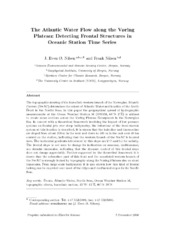The Atlantic Water flow along the Vøring Plateau: Detecting frontal structures in oceanic station time series
Journal article
Submitted version

Åpne
Permanent lenke
https://hdl.handle.net/1956/2176Utgivelsesdato
2007-01-13Metadata
Vis full innførselSamlinger
- Geophysical Institute [1198]
Originalversjon
Deep Sea Research Part I: Oceanographic Research Papers. 2007, 54 (3), 297-319. https://doi.org/10.1016/j.dsr.2006.12.012Sammendrag
The topographic steering of the baroclinic western branch of the Norwegian Atlantic Current (NwAC) determines the extent of Atlantic Water and location of the Arctic Front in the Nordic Seas. In this paper the geographical spread of hydrographic measurements at the Ocean Weather Station M (OWSM, 66°N 2°E) is utilised to create mean sections across the Vøring Plateau Escarpment in the Norwegian Sea. In concert with a theoretical framework involving the impact of low pressure systems on frontal jets over steep bathymetry, the behaviour of the front-current system at this location is described. It is shown that the halocline and thermocline are sloped from about 200 m in the west and down to 400 m in the east over 40 km centred on the station, indicating that the western branch of the NwAC is located here. The horizontal gradients introduced by this slope are 2°C and 0.1 for salinity. The frontal slope is not seen to change its inclination on seasonal, multi-annual, nor decadal timescales, indicating that the dynamic control of this frontal slope does not change appreciably. Further supported by the theoretical framework it is shown that the subsurface part of this front and the associated western branch of the NwAC is strongly locked by topography along the Vøring Plateau also on short timescales. From large scale bathymetry it is also shown how this kind of frontal locking can be expected over most of the ridges and continental slopes in the Nordic Seas.